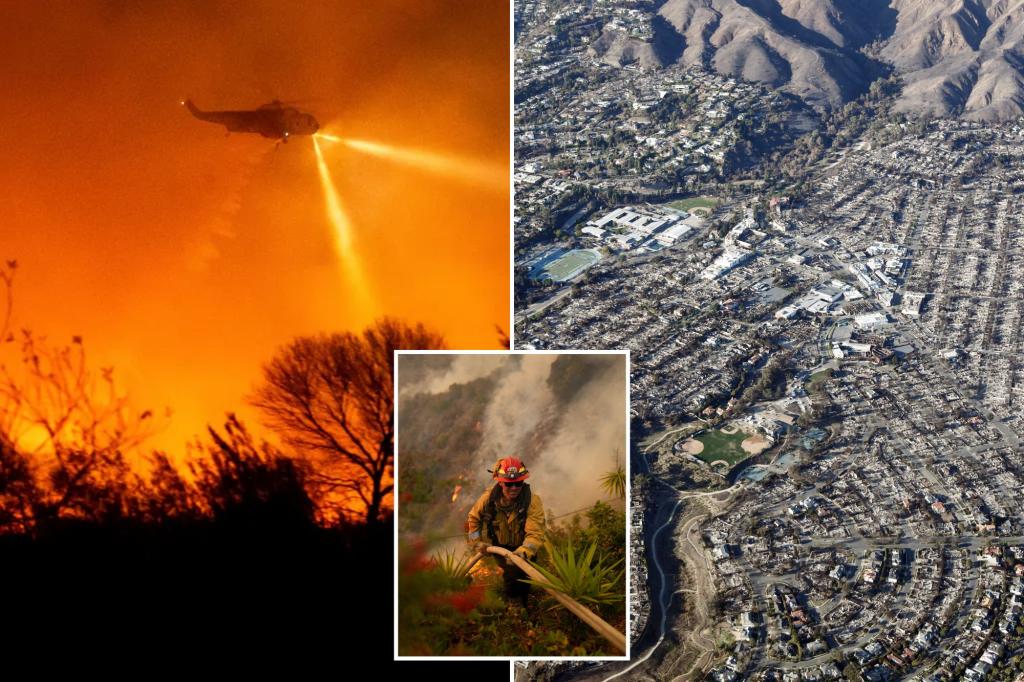The emergence of the Auto Fire in Ventura County late Monday night adds another layer of complexity to the ongoing wildfire crisis gripping Southern California. While relatively small at 56 acres and contained to the river bottom, posing no immediate threat to structures, its appearance underscores the volatile conditions prevailing in the region. The fire’s rapid spread, even before crews could fully mobilize, highlights the potency of the dry conditions and the effectiveness of the Santa Ana winds in driving fire growth. This new blaze comes as firefighters continue their relentless battle against multiple other wildfires that have already tragically claimed 24 lives and left dozens missing, a number feared to rise as search and rescue efforts continue through the charred remains of homes and communities. The collective impact of these fires paints a grim picture of devastation across the Southern California landscape.
The already dire situation is further exacerbated by a “Particularly Dangerous Situation” Fire Weather Warning issued for Southern California. This warning signals a confluence of factors creating a highly conducive environment for wildfire ignition and rapid spread. Critically low humidity levels, combined with the resurgence of the infamous Santa Ana winds, have elevated the risk to extreme levels. These winds, known for their dry, downslope characteristics, are capable of fanning even the smallest embers into raging infernos. While the wind speeds in some areas are not as intense as those experienced during the initial outbreak of the fires last week, they remain a significant threat, capable of driving erratic fire behavior and hindering containment efforts. Of particular concern is Ventura County, where wind speeds have surpassed those observed last week, further emphasizing the precarious nature of the current fire situation.
The Santa Ana winds, a defining feature of Southern California’s fire season, are created by high-pressure systems over the Great Basin. This pressure gradient forces air downslope from the elevated desert regions towards the coast. As the air descends, it compresses and warms, drastically reducing its humidity. This dry, hot air becomes a potent catalyst for wildfire spread, readily drying out vegetation and carrying embers long distances, igniting new fires in its path. The combination of strong winds and low humidity creates a perfect storm for wildfire activity, making containment extremely challenging and putting communities at significant risk. The current fire weather warning highlights the particularly dangerous convergence of these conditions.
The ongoing wildfire crisis in Southern California has drawn a massive response from firefighters across the United States and even internationally. Crews are working around the clock in a relentless effort to contain the blazes and protect lives and property. The scale of the disaster underscores the need for a coordinated and comprehensive approach to wildfire management. The arduous task of searching through the debris for victims continues, a grim reminder of the human cost of these devastating fires. The search efforts, aided by K9 units and cadaver dogs, are emotionally taxing for the personnel involved, as they confront the tragic reality of the loss of life within the affected communities.
The forecast for the coming days offers a glimmer of hope, with predictions of weakening Santa Ana winds and a shift to onshore winds by Thursday. This change in wind direction is expected to bring an increase in humidity, providing some much-needed relief for firefighters battling the flames. The higher humidity will help to dampen the dry vegetation, making it less susceptible to ignition and slowing the spread of existing fires. While the fire weather warnings are expected to expire on Wednesday, the threat of wildfires remains a persistent concern in Southern California, particularly given the long-term drought conditions and the increasing frequency of extreme weather events.
The ongoing wildfires in Southern California represent a complex and evolving situation, driven by a combination of natural factors and human influences. The Santa Ana winds, dry conditions, and abundant fuel sources create a highly flammable environment, while climate change is believed to be exacerbating these conditions, leading to longer and more intense fire seasons. The tragic loss of life and the widespread destruction serve as a stark reminder of the devastating power of wildfires and the urgent need for comprehensive strategies to mitigate their impact. The heroic efforts of firefighters, coupled with the anticipated shift in weather patterns, offer a hopeful outlook for containing the current blazes. However, the long-term challenge of wildfire management in a changing climate remains a critical issue requiring ongoing attention and investment.

